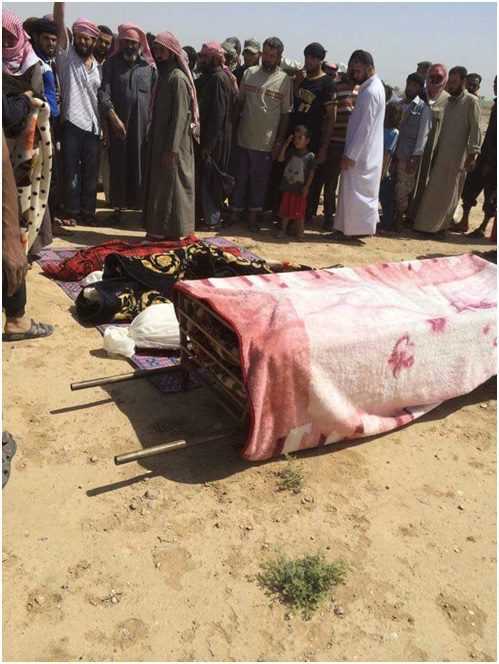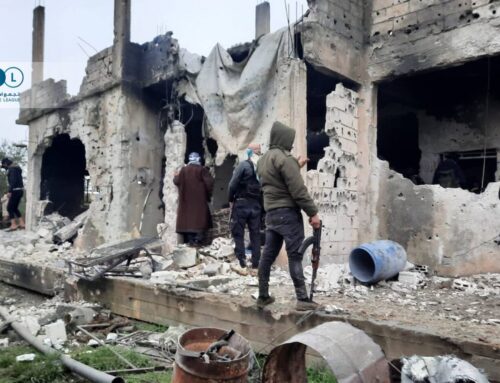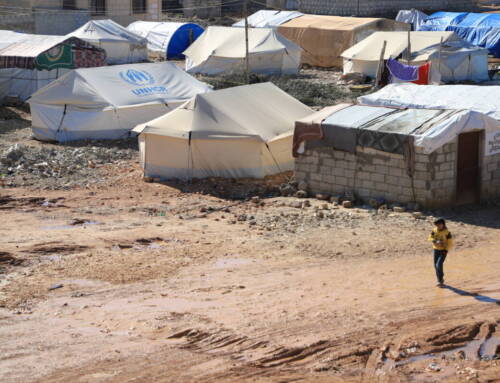Syrian regime airstrikes reportedly target Islamic State’s Deir e-Zor territory
On Monday, a series of more than 10 airstrikes—of unconfirmed […]
8 June 2016
On Monday, a series of more than 10 airstrikes—of unconfirmed provenance—slammed villages and towns under Islamic State control Deir e-Zor. The attacks across the eastern countryside and provincial capital killed more than 25 people, sources tell Syria Direct.
On Tuesday, regime military sources told SANA, Syria’s state news agency, that “the Syrian Air Force carried out dawn raids on IS positions and fortified positions in Deir e-Zor…killing a number of IS terrorists.”
In this instance, the Syrian air force appears to claim the strikes. But in most cases, neither Moscow nor Damascus comment, leaving activists and others left to determine the origin of the attacks based on sound and plane formation.
“We believe that Syrian regime warplanes carried out these airstrikes,” Jalal al-Hamed, director of the Turkey-based human rights group Justice for Life Observatory in Deir e-Zor, tells Syria Direct.
Only one plane appeared to carry out Monday’s strikes, al-Hamad tells Syria Direct’s Mohammed al-Haj Ali. “It executed a low-flying, sudden assault and produced a deafeningly loud noise… These are all telltale signs of regime attacks.”
IS took control of large swaths of the oil-rich, eastern desert province in a lightening advance in the summer of 2014, following the capture of Mosul in neighboring Iraq. Today, the Islamic State either encircles or directly controls roughly half of Deir e-Zor province, including the provincial capital’s 200,000 residents, despite regime advances to retake lost territory.
Q: When did the airstrikes begin? Which areas were targeted?
The airstrikes took place Monday morning between 9:00am and 10:00am.
In the eastern Deir e-Zor countryside, they targeted the towns of al-Asharah, al-Qurayyah, a-Shahil, Boqruss Foqani, Saelo, al-Marieh and al-Jafra.
Inside the provincial capital of Deir e-Zor city, the bombings targeted IS-controlled neighborhoods, including al-Orrdey, al-Hawiqa, al-Jabila.
A series of three airstrikes also targeted IS locations surrounding the Deir e-Zor military airport. [Ed.: While the regime controls the airport, IS has the location surrounded.]

Q: Several media outlets claim that Russia was behind this recent wave of airstrikes; however, the Russian Defense Ministry categorically denies this charge. How are you able to distinguish between Russian and regime warplanes?
We believe that Syrian regime warplanes carried out these airstrikes. While we cannot be completely certain of the provenance of these attacks, we look to a number of signs and indicators to determine origin.
With regard to Monday’s attacks, there was only one plane, it executed a low-flying, sudden assault and it produced a deafeningly loud noise. These are all telltale signs of regime attacks. On the other hand, Russian jets rarely fly alone. They normally fly in a five- to six-plane formation. They also bomb from a much higher altitude, to the point where we can barely even see the planes. In turn, they produce a quieter sound in comparison to the thunderous regime planes. With these indicators, we are able to distinguish between Russian and regime warplanes.
Q: What was the fallout of Monday’s airstrikes?
Al-Asharah suffered the greatest losses—as many as 20 victims—half of whom were women and children.
[Ed.: Al-Asharah presents minimal strategic significance; however, the airstrikes targeted a popular civilian street, seemingly to inflict the maximum possible damage.]We have reason to believe that this figure will continue to rise for two reasons. First, the bombings targeted a densely populated civilian area, resulting in dozens of people who were critically injured. Secondly, we only record casualties after visual confirmation of the deceased. As such, it is likely that there are a number of victims who we still have not yet come across.
Q: Describe the medical situation in Deir e-Zor territory under IS control. Are there Civil Defense Units or well-equipped hospitals?
While there are no Civil Defense Units in these areas, there are some medical centers. These centers, however, cannot provide the full range of medical services, and they certainly cannot accommodate the full volume of patients in the province. It’s clear that the medical situation is getting progressively worse in Deir e-Zor.
The most serious medical cases require relocating the patients to facilities in Damascus, al-Bukamal or Iraq; however, securing travel permits can be incredibly difficult. In order to go to Damascus, one has to get permission from the Hisbah [Ed.: IS religious police]. The vast majority of these travel requests are ultimately shot down—even for those who are in desperate need of medical treatment.
Q: Do you believe that IS uses civilians as human shields when they situate their offices and operations in densely populated locations?
Without a doubt, IS sets up shop among civilians. They even hide their weapons depots within crowded civilian areas. That being said, Monday’s airstrikes strictly targeted markets. In Boqruss, the attacks hit the village’s most densely populated area, which is filled with homes, stores and merchants. In al-Asharah, the airstrikes targeted al-Bareed street, which, similarly, is the most densely populated street in the town.







